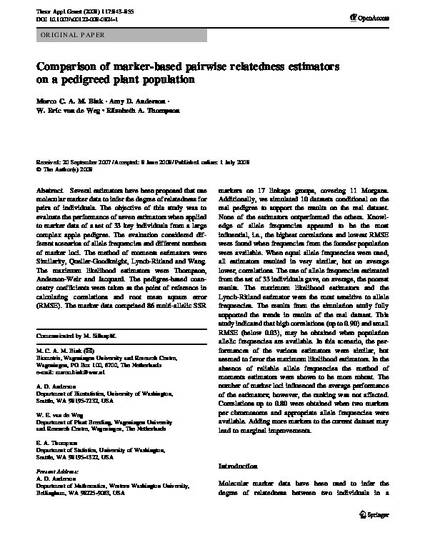
Several estimators have been proposed that use molecular marker data to infer the degree of relatedness for pairs of individuals. The objective of this study was to evaluate the performance of seven estimators when applied to marker data of a set of 33 key individuals from a large complex apple pedigree. The evaluation considered different scenarios of allele frequencies and different numbers of marker loci. The method of moments estimators were Similarity, Queller-Goodknight, Lynch-Ritland and Wang. The maximum likelihood estimators were Thompson, Anderson-Weir and Jacquard. The pedigree-based coancestry coefficients were taken as the point of reference in calculating correlations and root mean square error (RMSE). The marker data comprised 86 multi-allelic SSR markers on 17 linkage groups, covering 11 Morgans. Additionally, we simulated 10 datasets conditional on the real pedigree to support the results on the real dataset. None of the estimators outperformed the others. Knowledge of allele frequencies appeared to be the most influential, i.e., the highest correlations and lowest RMSE were found when frequencies from the founder population were available. When equal allele frequencies were used, all estimators resulted in very similar, but on average lower, correlations. The use of allele frequencies estimated from the set of 33 individuals gave, on average, the poorest results. The maximum likelihood estimators and the Lynch-Ritland estimator were the most sensitive to allele frequencies. The results from the simulation study fully supported the trends in results of the real dataset. This study indicated that high correlations (up to 0.90) and small RMSE (below 0.03), may be obtained when population allelic frequencies are available. In this scenario, the performances of the various estimators were similar, but seemed to favor the maximum likelihood estimators. In the absence of reliable allele frequencies the method of moments estimators were shown to be more robust. The number of marker loci influenced the average performance of the estimators; however, the ranking was not affected. Correlations up to 0.80 were obtained when two markers per chromosome and appropriate allele frequencies were available. Adding more markers to the current dataset may lead to marginal improvements.
Available at: http://works.bepress.com/amy_anderson/3/
